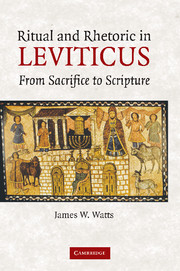Book contents
- Frontmatter
- Contents
- Abbreviations
- Preface
- Ritual and rhetoric in Leviticus
- 1 Introduction: Ritual Text and Ritual Interpretation
- 2 The Rhetoric of Ritual Instruction
- 3 The Rhetoric of Burnt Offerings
- 4 The Rhetoric of Sin, Guilt, and Ritual Offerings
- 5 The Rhetoric of Ritual Narrative
- 6 The Rhetoric of Atonement
- 7 The Rhetoric of Priesthood
- 8 The Rhetoric of Sacrifice
- 9 The Rhetoric of Scripture
- Bibliography
- Index of Biblical Citations
- Index of Other Ancient Literature
- Index of Authors
- Index of Subjects
2 - The Rhetoric of Ritual Instruction
Published online by Cambridge University Press: 22 July 2009
- Frontmatter
- Contents
- Abbreviations
- Preface
- Ritual and rhetoric in Leviticus
- 1 Introduction: Ritual Text and Ritual Interpretation
- 2 The Rhetoric of Ritual Instruction
- 3 The Rhetoric of Burnt Offerings
- 4 The Rhetoric of Sin, Guilt, and Ritual Offerings
- 5 The Rhetoric of Ritual Narrative
- 6 The Rhetoric of Atonement
- 7 The Rhetoric of Priesthood
- 8 The Rhetoric of Sacrifice
- 9 The Rhetoric of Scripture
- Bibliography
- Index of Biblical Citations
- Index of Other Ancient Literature
- Index of Authors
- Index of Subjects
Summary
Formal and structural features of Leviticus 1–7 distinguish these chapters as some of the most systematic texts in the Hebrew Bible. In a collection of literature otherwise noted for its sweeping narratives and urgent sermons, these methodical instructions for the performance of five kinds of offerings, presented twice in different arrangements, have suggested to many interpreters that they preserve examples of an ancient genre of ritual instruction. However, the identification of a ritual genre in these chapters (and elsewhere in the Pentateuch) has failed to account for all of the features of this material. The present form of Leviticus 1–7 can be better understood as a product of the same process of generic mixture and allusion apparent in many other biblical texts.
I have argued elsewhere that the large-scale structure of the Pentateuch and several of its constituent parts has been shaped by a rhetorical strategy that combines diverse materials for persuasive effect. Thus the narratives of Genesis and Exodus ground the authority of the divine lawgiver on the basis of past acts of creation, blessing, and salvation; the laws and instructions of Exodus, Leviticus, and Numbers stipulate behavior in the present; while the blessings and curses that conclude Leviticus and Deuteronomy, and that in the larger context characterize Deuteronomy as a whole, depict the possible futures determined by Israel's response to the laws.
- Type
- Chapter
- Information
- Ritual and Rhetoric in LeviticusFrom Sacrifice to Scripture, pp. 37 - 62Publisher: Cambridge University PressPrint publication year: 2007



